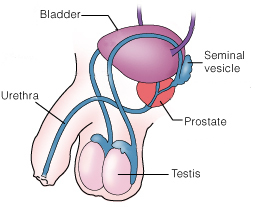PROSTATE CANCER – Know your enemy

What is your prostate?
The prostate is a male gland the size of a walnut. It is situated below the bladder. The urethra, which is the conduit for both urine and semen, passes through the prostate. The function of the prostate is to produce seminal fluid.
What is prostate cancer?
It is not always aggressive or life-threatening. However, one quarter of new cancer cases in men in the UK are due to prostate cancer and it is the second biggest cause of cancer deaths in men in the UK.
Cancer has two distinctive features – it can grow in an uncontrolled way or it can escape from the original site and invade other parts of the body. In cancer escapes from the prostate it can spread to the adjacent seminal vesicles or erectile nerves. If it spreads further it can enter the blood or lymphatic systems and circulate throughout the body. Not all cancer cells grow rapidly in an uncontrolled way. So a prostate cancer diagnosis is not necessarily a cause for ‘doom and gloom’. Every year 40,000 UK men are diagnosed and more than 10,000 die of this cancer each year – that’s more than one dying every hour of every day. And there are more than 250,000 men living with the disease in the UK today. But 84% of men are predicted to survive the disease for 10 years or more. More information on our Helpful links page.
Risk factors for prostate cancer
Age is the No 1 risk factor. The chances of developing the disease increase as you get older. It is rare in men under 40, and 60% of cases are in men over 70.
Family history If a close relative developed prostate cancer before he was 60, you are four times more likely to develop it.
Ethnicity The highest rates of this cancer are recorded in Afro-Caribbean men.
Diets high in red meats and saturated fats are considered a contributory factor.
Asbestos: Studies have shown an association between asbestos exposure and this cancer. Although research on the topic is limited, existing findings provide some insight into potential causal relationships. More research and studies are required to provide definitive conclusions on this relationship. The best thing to do is try to prevent exposure, but if men are exposed they should certainly get early screenings to catch the disease in its early stages (July ’17). See here. And on this site there is more help about asbestos in homes. Also Mesothelioma.net provides treatment information, 24/7 online support, financial aid, and much more to anyone who might have been exposed and affected by the cancer-causing substance through American-made products.
What can I do to reduce my risk?
Follow this link for the latest information Cancer Research UK